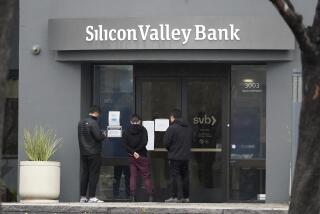A New Hedging Device, ‘SuperTrust,’ Is on Tap : Investing: Creators of the failed ‘portfolio insurance’ try again. They think holders can avoid the kind of stock losses suffered in October, 1987.
- Share via
Like Schwarzenegger in “The Terminator,” the rocket scientists whose computerized trading games were defeated by the 1987 stock market crash vowed that they’d be back.
Give us time, they said, and we’ll devise a new way for investors large and small to hedge against bear markets. And this time, they implied, it might even work.
Four and a half years later, the most celebrated of the rocket scientists--the Los Angeles investment firm of Leland O’Brien Rubinstein Associates--has finally readied its new “SuperTrust” investment vehicle for the market.
But in a painful setback for the firm, its attempt to raise $2 billion in seed money for SuperTrust since spring has come up 50% short. Because LOR got Securities and Exchange Commission approval based on a $2-billion minimum, the cash raised must be returned to investors. And LOR must persuade the SEC to allow a new offering based on a less-ambitious asset base.
John O’Brien, LOR’s chief executive, estimates that the relaunch of SuperTrust will take only a matter of months. But his disappointment is obvious given LOR’s huge investment in SuperTrust since 1988--a stunning $5 million in direct development costs.
For an 18-person firm whose annual revenue is perhaps $4 million, that is hardly small change.
If most investors aren’t shedding tears over SuperTrust’s delay, it’s understandable: Even the relative few pros who have tried to wade through the reams of LOR literature on the product--which actually encompasses six separate, yet interconnected, investments--say that its complexity is daunting.
O’Brien, a genial 55-year-old, doesn’t dispute that SuperTrust presents a challenge. But he contends that the real problem is that investors are viewing SuperTrust as a monolith instead of as a menu from which they can select investments that fit their specific needs.
“We misjudged how to get people to focus on the parts important to them,” O’Brien concedes. And it’s that aspect of tailor-made investing--each according to his or her personal risk tolerance--that O’Brien believes makes SuperTrust the prototype investment lunch cart of the future.
What Wall Street has been expecting from LOR since 1988, however, is simply a new way to protect a stock portfolio against a major market crash. LOR’s original concept, the much-ballyhooed “portfolio insurance” of the 1980s, self-destructed on Oct. 19, 1987, when the stock market collapsed.
A 1979 creation of two UC Berkeley professors, Hayne Leland and Mark Rubinstein, portfolio insurance was supposed to ensure that the user could limit losses in a down market to a prescribed amount, usually around 5%.
The key to the system was the use of a computer to perpetually juggle a mix of stocks, Treasury bills and stock index futures contracts--the latter providing a low-money-down way to hedge one’s bet on the market’s future direction, up or down. If the stock market began to head south, the computer would automatically rebalance the investor’s portfolio to minimize losses.
O’Brien, a brokerage executive in the 1970s, persuaded Leland and Rubinstein in 1981 that they should market portfolio insurance to money managers.
The pitch ultimately sold beyond LOR’s wildest dreams: The firm became synonymous in the ‘80s with the computer-directed, risk-controlled portfolio management that was all the rage on Wall Street. By 1987, LOR was directly managing $5 billion for clients, and its brand of portfolio insurance was licensed on another $45 billion.
But when the market crashed on Oct. 19 of that year, LOR learned the limitations of the system: It assumed that markets would always be orderly and that someone would be around to buy stocks or stock futures when LOR’s computers opted to sell.
On Oct. 19, there were virtually no buyers; there was certainly no order. Portfolio insurance’s popularity doomed it, because too many money managers rushed for the fire door at once.
Unable to get out of stocks on computer cue, many LOR clients suffered horrendous losses. Portfolio insurance became discredited almost overnight. LOR went back to the blackboard.
Enter SuperTrust. What LOR is attempting to create with this Herculean-sounding product is a large controlled market within the larger uncontrollable market.
SuperTrust would be a holding tank for billions of dollars in stocks and short-term U.S. Treasury securities that would in theory stay put as collateral. The stocks’ prices would follow the free market (the trust would replicate the Standard & Poor’s index of 500 blue-chip issues). And playing off the trust, investors could make any number of bets on the market.
You could, for example, “buy” the whole stock portfolio; own just the stocks’ future dividends; or own a special piece of the Treasury portfolio that would function as a hedge against a stock market collapse. For each bet you would make, SuperTrust is set up so that another investor, in effect, would be making the opposite bet. The securities would be freely tradable on the American Stock Exchange or Chicago Board Options Exchange.
The controlled aspect of the portfolio--specifically, that all bets and promises SuperTrust investors make to each other would be fully collateralized by the securities in the trust--is what would ensure the orderly markets necessary to keep gains and losses within the parameters each investor would effectively choose in advance.
As O’Brien notes, the problem with stock index futures contracts in October, 1987--and today--is that nothing is behind them but a promise to pay.
“It seemed to us that the answer lay in creating securities that were issued from a trust that had all the necessary assets to back up the security promises,” O’Brien says.
Put another way, SuperTrust assumes that your buy and sell decisions will be based purely on your rational expectations about the market--not worries about the ability to pay off the person on the other end of the transaction.
But if SuperTrust is such a perfect, rational marketplace, why couldn’t LOR raise $2 billion in commitments to launch it?
William Sharpe, professor of finance at Stanford University, argues that LOR may have outfoxed itself by designing SuperTrust to do so much. In the 4 1/2-year gestation period, other Wall Street firms were creating piecemeal new products that clients could use to make or hedge specific market bets.
“A lot of things have happened since LOR came up with this,” says Sharpe. One major development is the so-called swap market, wherein big investors essentially trade securities risk with each other.
Other Wall Streeters argue that while SuperTrust does afford some new flexibility in trading and investing in the stock market, there isn’t enough of a difference from existing products to lure buyers.
For example, the only major advantage SuperTrust has over an S&P; 500 index stock mutual fund is that investors can bail out of most funds only once a day, at the close--while the SuperTrust units would be tradable at prevailing prices throughout the day.
Gus Sauter, manager of the Vanguard Index Trust 500 mutual fund, doubts that most small investors would care much about intra-day trading. Still other critics contend that the fees LOR set on the various SuperTrust pieces were too high. LOR cut its fees three times in the course of the offering.
O’Brien insists that his biggest marketing problem simply has been the issue of turf.
“Wall Street has been passively negative about SuperTrust because it represents significant competition to very lucrative businesses that they already have,” O’Brien maintains.
In the case of individual investors, he says, “We’re trying to empower the ultimate asset-holder to do things he has relied on a broker to do for him”--buy a basket of securities, hedge a portfolio, seek a high dividend/low volatility investment, etc.
“SuperTrust cuts through all of the complicated nonsense and presents people with a security that does the job. And that’s going to potentially cannibalize (brokerage) revenues,” O’Brien says.
Yet for all of the competitors who may not want SuperTrust to make it, O’Brien notes that many big names stand with LOR. The initial $1 billion LOR raised came from such major institutional investors as College Retirement Equities Fund, Harvard University and General Electric.
LOR now must retain those commitments as it relaunches SuperTrust. More important, to succeed, SuperTrust must ultimately grow to many billions of dollars in size--because only active trading and liquidity can assure the viability of the market.
As a much smaller firm than what it was in 1987, LOR may well have bet the ranch on SuperTrust. O’Brien concedes that LOR manages only $750 million directly for clients today, a measure of how far the firm’s star has fallen since ’87.
While the $5 million in development expenses for SuperTrust have been funded with help from LOR’s corporate partners, the cost also undoubtedly sapped a large chunk of O’Brien’s personal wealth, as well as that of Leland, 51, and Rubinstein, 48.
O’Brien admits that SuperTrust has been a drain. But he says he has no doubt that it will fly because it gives investors a vast new range of choices.
“Think of things like the VCR, . . . like voice mail--all of these things, when they first came out, people thought they were hopelessly complicated,” O’Brien says. “But that’s just because they hadn’t seen them before.”
SuperTrust, Piece by Piece
Leland O’Brien Rubinstein’s SuperTrust is a proposed investment vehicle that would allow an investor to construct a broad stock market portfolio that fits the individual’s personal risk and return goals. A look at the six pieces of SuperTrust:
* Index Trust SuperUnit: Trading on the American Stock Exchange in $1,000 initial minimums, each unit would represent a share of an underlying portfolio of S&P; 500 stocks--thus, it’s a bet on the broad market, expiring in three years. Each unit could also be split into two “SuperShares” trading on the Chicago Board Options Exchange.
* Appreciation SuperShare: A bet that stock prices will soar over the next three years, this share would earn all price appreciation in the underlying stocks over a set amount. If stocks slump, this share could wind up worthless. It would be similar to a “call” option on the S&P; 500.
* Priority SuperShare: A conservative bet on the market, this share would earn all dividends paid on the underlying stocks in the three-year period, but only a capped amount of any appreciation in the stocks.
* Money Market Trust SuperUnit: Trading on the American Stock Exchange, each unit would represent a share of a portfolio of short-term U.S. Treasury securities, and earn a yield accordingly. The asset value is expected to remain constant at $50 per unit. Each unit could also be split into two “SuperShares” trading on the Chicago Board Options Exchange:
* Protection SuperShare: Once split from the SuperUnit, these effectively would become a capped “put” option on the S&P; 500--that is, they would be worth something only if the stock market plunges over the next three years. Could be used to bet on a stock slump.
* Income and Residual SuperShare: Once split from the SuperUnit, these would earn the interest return on the Treasury securities, and retain all of the assets of the SuperUnit, assuming the stock market rises. If the market slumps, however, these would drop in value by predetermined amounts.
Source: Leland O’Brien Rubinstein Associates
More to Read
Inside the business of entertainment
The Wide Shot brings you news, analysis and insights on everything from streaming wars to production — and what it all means for the future.
You may occasionally receive promotional content from the Los Angeles Times.










